Echo Amphitheater: Mineral or Murder?
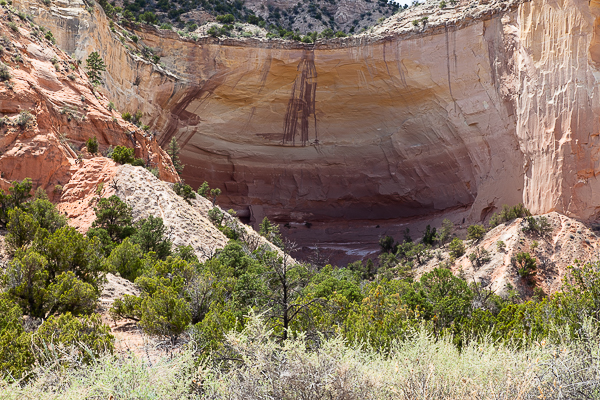
Echo Amphitheater in Northern New Mexico is known for unique echoing auditory properties. We chose it Sunday as the destination point for our drive through the Jemez. The entire drive was breathtaking. As a brief thunderstorm approached, the light on the sandstone cliffs after we rounded Abiquiu Lake was spectacular. So many different layers of colors were visible. On reaching the Amphitheater itself, in shade from clouds overhead, I did not immediately appreciate the colors. They appeared muted.
From the parking lot, a very nice walk leads to the Amphitheater itself.
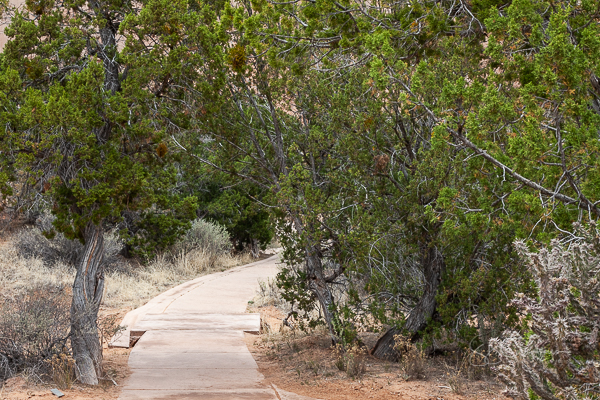
As we walked in, I was impressed with patterns hollowed out in the sandstone by running water. In addition, I noted small trees growing in cracks, which would, of course, lead to larger cracks and falling rocks over time.
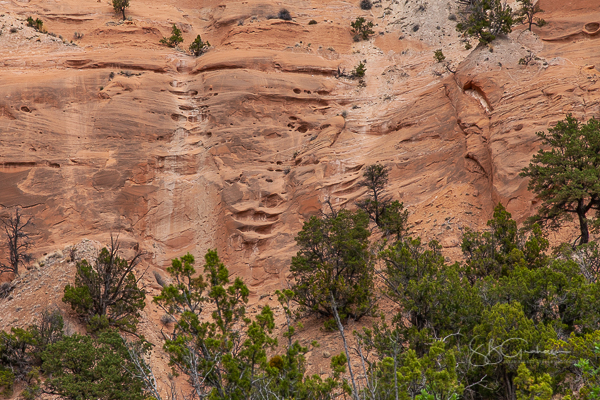
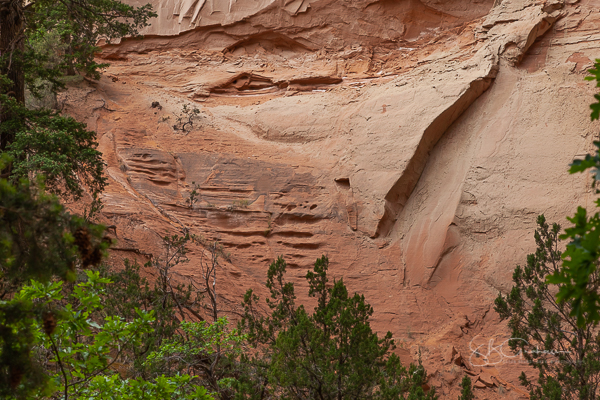
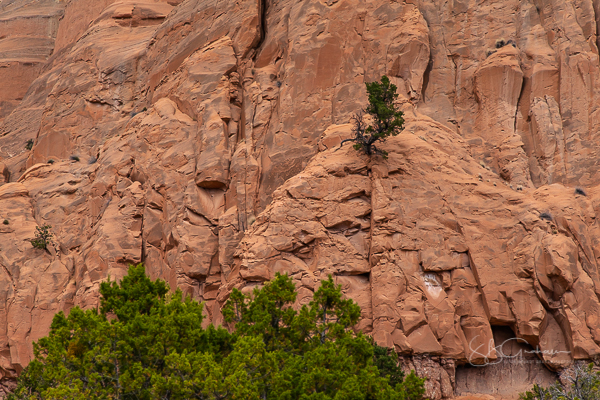
At the very end are stairs. At the top of the stairs is a landing on which you stand in front of the center of the Amphitheater. This is the point for the best echoes. Of course we clapped hands, said “Hello,” and a variety of other things. Things really do echo!!!
We photographed the impressive stains running down the sandstone.
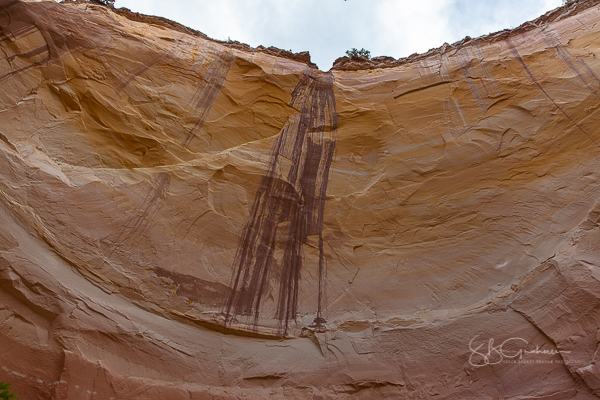
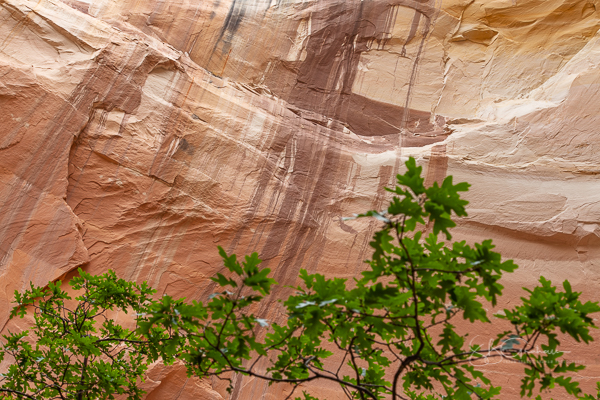
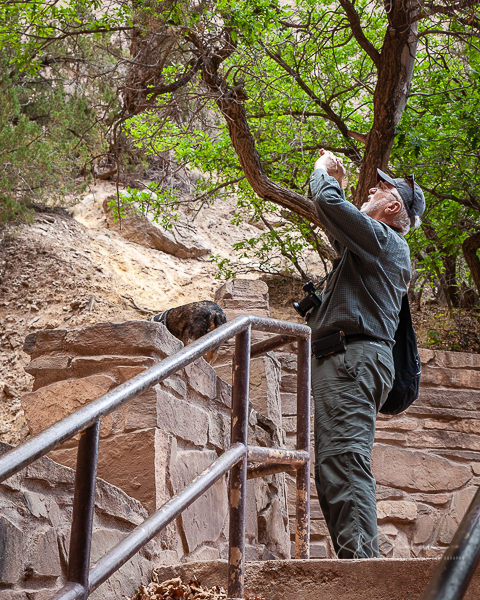
At the time we were there, I thought the stains were probably from iron carried in running water during storms. Today, however, I decided to see what I could find about minerals that might have caused the stains, whether iron, manganese, or something else or a combination. I easily found an overview of minerals in the region. I took this photograph as we were leaving the site.
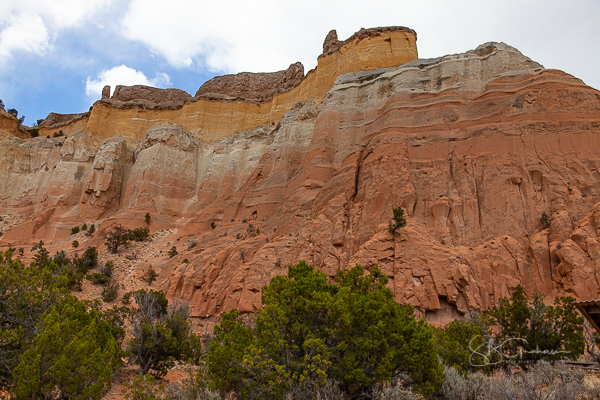
I have not yet found a scientific analysis of the mineral(s) streaking the sandstone.
However, I did find an Old West myth in the Atlas Obscura:
According to legend the curved stone cliff wall now known as Echo Amphitheater was the site where a group of Navajo executed a family of settlers. As the story goes, the victims were brought to the top of the cliff and killed, their blood running down the cliff wall and permanently staining it. Possibly in response to this legend another story says that years later a number of Navajo were in turn murdered in the same spot, once again staining the cliff wall with their draining blood. Now the natural echoing caused by the site’s geography is often ascribed to the voices of the unquiet dead.
I guess that can serve as an alternative explanation while I continue to search for a scientific explanation. The fact a story like that never occurred to me when looking at the Amphitheater at the time or the images later confirms the thoughts of a friend that my scientific view of the natural world prevents any possibility of a story telling imagination. 😉
——————————————————————————————————–
Old West Murders
Old west murders really are not my thing, but seem to be a recurring theme for some reason this spring. I’m still working through all of the things I have found from simply following things out from the DNA test I did just before Christmas. On my father’s mother’s side, one 2nd great grandfather was William Benjamin McKaughan and my 2nd great grandmother was Charlotte Clarenda “Lottie” Spencer (I guess I really am part Irish and part English). They married in Nacogdoches, Texas in 1852. He purchased properties along rivers in Texas, and became a merchant. In the 1860 Federal Census he had significantly more land and personal property than any of my other relatives at that time. Then came the Civil War, and all of my relatives as far as I can determine were Confederates. I’m still working on swallowing that. They had more children after the Civil War ended. He became known in Dallas for business trips he made after the Civil War. Then, on May 5, 1868 he was murdered. The generally accepted story is that one of Charlotte’s brothers (would be a great grand uncle of mine) killed him over a “family matter” (nothing more specified). The Spencer brothers were also merchants, but I do not know if they worked together or were competitors. But I found one website where someone says quite simply, “His wife killed him and her brother took the rap.” I have no idea, but I am trying to find out more. No one in my family talked about that 🙂 )))))))))) It was new to me!
In the 1870 Federal Census Charlotte was still living in Belton, Texas with her younger children. She did not possess William B’s land, but still had a fair amount of personal property. By the 1880 Federal Census she was living with an older daughter as well as some of the younger children in Nacogdoches, Texas. The 1890 Federal Census burned. In the 1900 Federal Census she was living in San Antonio with my great grandmother, Mary Rosella Mckaughan Webb and her third husband, George C Webb, along with two of her grandchildren – my grandmother and great aunt – and also her unmarried younger daughter, “Mattie” McKaughan. Charlotte died in San Antonio in 1902, and is buried in the Confederate Cemetery there.
When I graduated from medical school, my father’s sister gave me a pair of earrings with the hand written note, “Charlotte Spencer McKaughan, mother of Mary R McKaughan.” No explanation beyond that was given, and it was the only time her name was mentioned to me in any way. William Benjamin McKaughan was never mentioned to me, and on old death certificates of various family members, both my grandmother and great aunt gave false information about his name and place of birth (and they didn’t even tell the same lie!). On one my grandmother said there was “no information” on who her aunt’s mother was, which would have been my grandmother’s grandmother, Charlotte Spencer McKaughan. I guess they figured telling different lies would make finding the truth that much more difficult. It was, and I’m still searching.
What happened to the body of William Benjamin McKaughan? I don’t know. He has a cenotaph memorial in Salado Cemetery, Texas.
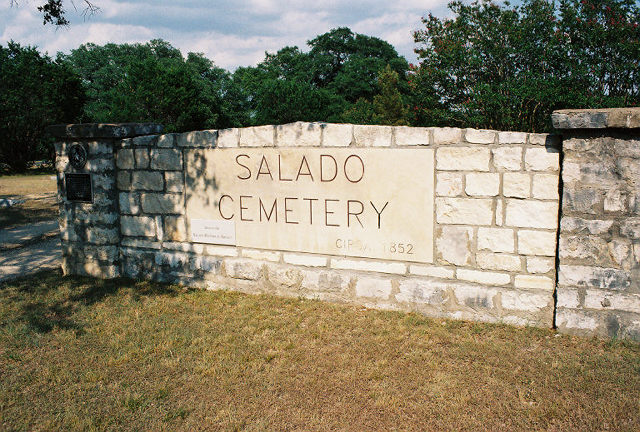
Forgive the digression…
———————————————————————————————————
Back to New Mexico
For those of you who live here, a day trip through Northern New Mexico with Echo Amphitheater as a destination point is fun. Plan many stops along the way for colorful vistas and photographs. See what your imagination tells you. Thanks for coming along with me on this trip.




Reds rocks of northern New Mexico are so beautiful. Just think, in a few million years the echo chamber could become an arch. We have a lot of interesting history in NM and the SW.
Hi, Tim. Every one of your points is so true. That whole area is full of chambers which may not echo, but which could certainly possibly become arches over time. It was a great trip. (I’m so happy to live in New Mexico!!! 🙂 )
Your photographs, Suzan, are wonderful. What a lovely state you live in. And your investigations into the causes of the phenomena you see adds many more dimensions. Thank you.
Hi, Pearl! So nice to see you. I know how fortunate I am to be here. It was really good to get out again, and I’m going to try to do it a little more often. Thank you so much for dropping by! 🙂
Your story is so interesting. Keep us posted on further developments. Give my regards to your mother. Such a sweet and remarkable lady.
Hi, Shirley! I’ll be happy to do that! Thank you for dropping by and sharing this family story. So nice to see you! 🙂
Nice to see such beautiful scenery! When ever we catch up, I have a DNA story of mine to tell you.
Hi, Donaldina! It was beautiful, and a perfect day that was cool and with cloud cover intermittently. I’m looking forward to your DNA story!!! I remember the first day I met you (Sacramento), and the history you told me when I asked about your name. Thanks for stopping by!
Hi Susan – Greetings from San Juan Capistrano. We’re here over the next four weeks for horse shows. The cool is refreshing break from the heat back home in Colorado. I’m sure you wouldn’t mind it either.
The stains in the amphitheater are likely from other minerals. Sandstone is notorious for absorbing stains. Maybe iron, copper, or nickel comes to mind. Manganese, a long shot maybe. The American Southwest is not known for manganese deposits. Iron and copper are more likely. An analytical field kit is needed.
Old West murders, that’s a very interesting segment. I’ve read the Nacogdoches area wasn’t a particularly strong bastion of Confederate sympathy, and was largely had split feelings about either side. Most people had preferred to be left alone regarding the politics of the war. Many would say they were Confederate just be left alone, satisfying those who harbored stronger sentiments. Those men who did not go to war would say it would be difficult with having a non-functional long rifle or pistol. The Confederacy wasn’t really into arming their own soldiers and officers. Most of their arms were manufactured in the North. then, they were supplied by the British, who were playing both sides.
Like the new theme format, especially you wide image header.
Hi, David. Thanks for stopping by. I’m glad you have a cool place for part of the summer. Did you enjoy seeing Justify yesterday?